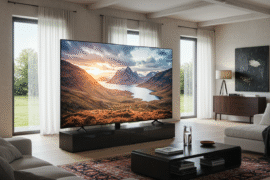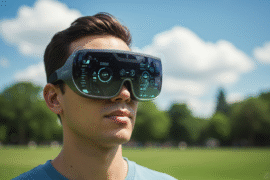This article may contain references to products or services from one or more of our advertisers or partners. We may receive compensation when you click on links to those products or services. Nonetheless, our opinions are our own.

Updated by Albert Fang
From the early days of print ads in newspapers and magazines to the eye-catching digital billboards that dominate our city landscapes, advertising has come a long way.
In today’s fast-paced digital age, where online ads seem to follow us everywhere we go, it’s hard to imagine a time when advertisements were limited to static images and catchy jingles.
Join us as we take a journey through the history of advertising and explore how it has evolved over the past decades.
The different types of advertising
Advertising takes many forms, each with its own unique characteristics and impact. Let’s dive into the different types of advertising that have shaped the industry over time.
- Print Advertising: This was one of the earliest forms of advertising, where brands would place their messages in newspapers, magazines, and even on flyers. From full-page spreads to eye-catching headlines, print ads captured audiences’ attention and conveyed information about products or services.
- Outdoor Advertising: Billboards adorned highways and city streets, captivating passersby with bold visuals and concise messaging. These larger-than-life displays became iconic symbols of modern advertising. Nowadays, digital billboards replaced most of the outdoor ads out there.
- Broadcast Advertising: Television and radio commercials revolutionized how brands reached audiences. With carefully crafted scripts and memorable jingles, these ads seamlessly integrated into our entertainment experiences.
- Direct Mail Marketing: Personalized letters or brochures delivered directly to consumers’ mailboxes allowed businesses to target specific demographics effectively.
- Online Advertising: The rise of the internet brought a new era for advertisers as they could reach global audiences instantly through banner ads, pop-ups, sponsored content, social media campaigns, and more.
- Influencer Marketing: In recent years, influencers on social media platforms have become powerful marketing tools for brands seeking authentic connections with their target audience.
As technology continues to advance rapidly, new modes of advertising will surely emerge – virtual reality experiences or interactive augmented reality advertisements may soon dominate our screens.
The ever-changing landscape of advertising ensures that there is always something fresh around the corner – keeping marketers on their toes as they strive to captivate consumer attention in innovative ways!
The history of advertising
The history of advertising can be traced back to ancient civilizations, where merchants would use simple signs and symbols to promote their goods. However, it was not until the 18th century that formal advertising began to take shape. With the advent of newspapers and magazines in the 19th century, print advertising became a popular medium for reaching a wider audience. Companies started placing advertisements in publications, using catchy slogans and eye-catching visuals to grab the attention of consumers.
In the early 20th century, radio emerged as another powerful platform for advertising. Advertisers realized they could reach millions of people through radio broadcasts, leading to an increase in sponsored programs and jingles that became ingrained in popular culture.
Television revolutionized advertising in the mid-20th century. With its ability to combine visual imagery with sound, television ads became more creative and engaging than ever before. Brands like Coca-Cola and Marlboro created iconic commercials that are still remembered today.
As technology advanced further, digital billboards started popping up on highways and city streets. These large electronic displays allowed advertisers to showcase dynamic content with vibrant colors and moving images. And if you’re wondering how much is a billboard in Times Square and if it’s worth the effort for a big company, it surely pays off.
And then came the internet age – a game-changer for advertising. Online ads took over websites, search engines, social media platforms, and even mobile apps. Advertisers now have access to highly targeted audiences based on demographics and interests.
Today’s world is filled with various forms of advertisement – from traditional print ads in newspapers or magazines to digital billboards flashing captivating messages along busy highways; from online pop-up ads on websites we visit daily or targeted social media campaigns that follow us around wherever we go!
Technological advancements have driven the evolution of advertising – each era bringing new opportunities for brands to connect with consumers in innovative ways. As time goes on, it will be fascinating to see how this ever-changing landscape continues shaping our future!
The Future of Advertising
As technology continues to advance at an unprecedented rate, the future of advertising holds limitless possibilities. With the rise of digital billboards and online ads, traditional print advertisements are slowly becoming a thing of the past.
One exciting development in advertising is the use of augmented reality (AR) and virtual reality (VR). Imagine trying on clothes or test drive a car from the comfort of your home! AR and VR have the potential to revolutionize how consumers interact with products and services.
Another trend that is gaining momentum is personalized advertising. Companies are using data analytics to tailor ads specifically for individual consumers based on their preferences, behaviors, and demographics. This level of personalization enhances user experience and increases engagement.
Influencer marketing has also become a powerful tool for reaching target audiences. Social media platforms such as Instagram, YouTube, and TikTok provide opportunities for brands to collaborate with influencers who have large followings. These partnerships create authentic connections between brands and consumers.
Furthermore, voice-activated devices like Amazon Echo and Google Home present new avenues for advertisers to engage with users through audio-based advertisements. As voice search becomes more prevalent, optimizing content for voice assistants will be crucial in capturing consumer attention.
Additionally, programmatic advertising is transforming how ad space is bought and sold. Automated systems analyze vast amounts of data in real-time to deliver targeted ads across various platforms efficiently.
Looking ahead into the future, artificial intelligence (AI) will continue playing a significant role in advertising strategies. AI can automate processes such as ad creation, targeting optimization, and performance tracking, making campaigns more efficient while reducing human error.
The future promises even further integration between offline experiences and online advertising channels through technologies like geolocation targeting or interactive displays that seamlessly connect physical spaces with digital content.
In conclusion, as we move forward into this ever-changing landscape where technological advancements shape our daily lives more than ever before; advertisers must adapt their strategies accordingly to stay relevant and effective. As we look into the future, it is clear that technology will continue driving innovation in advertising. Virtual reality (VR), augmented reality (AR), artificial intelligence (AI), and other emerging technologies hold tremendous potential for creating even more personalized experiences for consumers.

Reviewed and edited by Albert Fang.
See a typo or want to suggest an edit/revision to the content? Use the contact us form to provide feedback.
At FangWallet, we value editorial integrity and open collaboration in curating quality content for readers to enjoy. Much appreciated for the assist.
Did you like our article and find it insightful? We encourage sharing the article link with family and friends to benefit as well - better yet, sharing on social media. Thank you for the support! 🍉
Article Title: The Evolution of Advertising: From Print to Digital Billboards and Online Ads Over the Past Decades
https://fangwallet.com/2023/07/20/the-evolution-of-advertising-from-print-to-digital-billboards-and-online-ads-over-the-past-decades/The FangWallet Promise
FangWallet is an editorially independent resource - founded on breaking down challenging financial concepts for anyone to understand since 2014. While we adhere to editorial integrity, note that this post may contain references to products from our partners.
The FangWallet promise is always to have your best interest in mind and be transparent and honest about the financial picture.
Become an Insider

Subscribe to get a free daily budget planner printable to help get your money on track!
Make passive money the right way. No spam.
Editorial Disclaimer: The editorial content on this page is not provided by any of the companies mentioned. The opinions expressed here are the author's alone.
The content of this website is for informational purposes only and does not represent investment advice, or an offer or solicitation to buy or sell any security, investment, or product. Investors are encouraged to do their own due diligence, and, if necessary, consult professional advising before making any investment decisions. Investing involves a high degree of risk, and financial losses may occur including the potential loss of principal.
Source Citation References:
+ Inspo












































